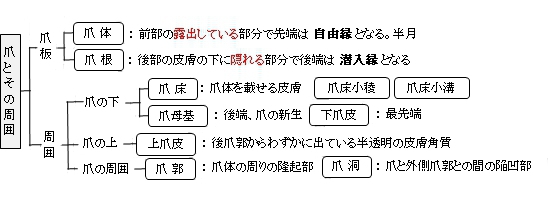

以下は「ウィキペディア」の解説文となる。
爪根を覆っている皮膚を「後爪郭」と言い、この部分からわずかに爪甲に覆うようにある半透明の皮膚角質を「爪上皮」(そうじょうひ、あるいは上爪皮、いわゆる「甘皮(あまかわ)」のこと)という。
以下は「Wikipedia」の解説文となる。
Together, the eponychium and the cuticle form a protective seal. The cuticle is the semi-circular layer of almost invisible dead skin cells that "ride out on" and cover the back of the visible nail plate. The eponychium is the fold of skin cells that produces the cuticle. They are continuous, and some references view them as one entity. (Thus the names eponychium, cuticle, and perionychium would be synonymous, although a distinction is still drawn here.) It is the cuticle (nonliving part) that is removed during a manicure, but the eponychium (living part) should not be touched due to risk of infection.[citation needed] The eponychium is a small band of living cells (epithelium) that extends from the posterior nail wall onto the base of the nail.
【語句】
・cuticle: ・reference:参考文献 ・entity:実存物 ・synonymous:道義の ・distinction:区別 ・infection:感染症
The eponychium is the end of the proximal fold that folds back upon itself to shed an epidermal layer of skin onto the newly formed nail plate.[contradictory] The perionyx is the projecting edge of the eponychium covering the proximal strip of the lunula.
The nail wall (vallum unguis) is the cutaneous fold overlapping the sides and proximal end of the nail. The lateral margin (margo lateralis) lies beneath the nail wall on the sides of the nail, and the nail groove or fold (sulcus matricis unguis) are the cutaneous slits into which the lateral margins are embedded.
【語句】
・proximal:近い方の ・shed:発する、与える ・epidermal:表皮性の ・perionyx:痕跡爪皮 ・lunula:半月 ・nail wall:爪郭 ・cutaneous:皮膚の ・nail groove/fold:爪洞 ・slit:裂け目
■ 写真やイラストを掲載しているサイト ■
・ イラストや写真を掲載しているサイト-Ⅰ
・ イラストや写真を掲載しているサイト-Ⅱ
・ イラストや写真を掲載しているサイト-Ⅲ
